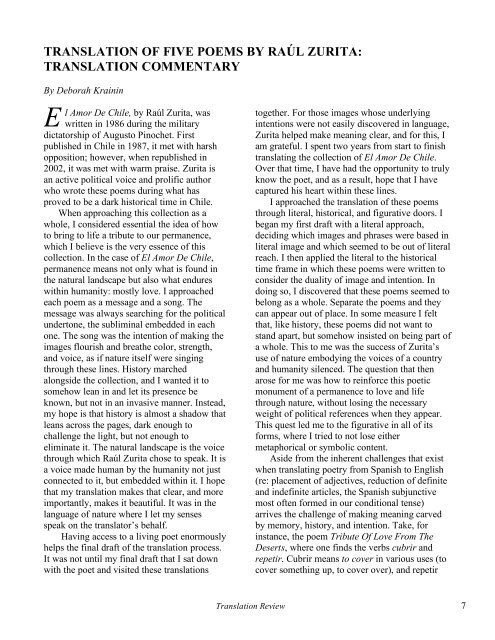table of contents - The University of Texas at Dallas
table of contents - The University of Texas at Dallas
table of contents - The University of Texas at Dallas
Create successful ePaper yourself
Turn your PDF publications into a flip-book with our unique Google optimized e-Paper software.
TRANSLATION OF FIVE POEMS BY RAÚL ZURITA:<br />
TRANSLATION COMMENTARY<br />
By Deborah Krainin<br />
E<br />
l Amor De Chile, by Raúl Zurita, was<br />
written in 1986 during the military<br />
dict<strong>at</strong>orship <strong>of</strong> Augusto Pinochet. First<br />
published in Chile in 1987, it met with harsh<br />
opposition; however, when republished in<br />
2002, it was met with warm praise. Zurita is<br />
an active political voice and prolific author<br />
who wrote these poems during wh<strong>at</strong> has<br />
proved to be a dark historical time in Chile.<br />
When approaching this collection as a<br />
whole, I considered essential the idea <strong>of</strong> how<br />
to bring to life a tribute to our permanence,<br />
which I believe is the very essence <strong>of</strong> this<br />
collection. In the case <strong>of</strong> El Amor De Chile,<br />
permanence means not only wh<strong>at</strong> is found in<br />
the n<strong>at</strong>ural landscape but also wh<strong>at</strong> endures<br />
within humanity: mostly love. I approached<br />
each poem as a message and a song. <strong>The</strong><br />
message was always searching for the political<br />
undertone, the subliminal embedded in each<br />
one. <strong>The</strong> song was the intention <strong>of</strong> making the<br />
images flourish and bre<strong>at</strong>he color, strength,<br />
and voice, as if n<strong>at</strong>ure itself were singing<br />
through these lines. History marched<br />
alongside the collection, and I wanted it to<br />
somehow lean in and let its presence be<br />
known, but not in an invasive manner. Instead,<br />
my hope is th<strong>at</strong> history is almost a shadow th<strong>at</strong><br />
leans across the pages, dark enough to<br />
challenge the light, but not enough to<br />
elimin<strong>at</strong>e it. <strong>The</strong> n<strong>at</strong>ural landscape is the voice<br />
through which Raúl Zurita chose to speak. It is<br />
a voice made human by the humanity not just<br />
connected to it, but embedded within it. I hope<br />
th<strong>at</strong> my transl<strong>at</strong>ion makes th<strong>at</strong> clear, and more<br />
importantly, makes it beautiful. It was in the<br />
language <strong>of</strong> n<strong>at</strong>ure where I let my senses<br />
speak on the transl<strong>at</strong>or’s behalf.<br />
Having access to a living poet enormously<br />
helps the final draft <strong>of</strong> the transl<strong>at</strong>ion process.<br />
It was not until my final draft th<strong>at</strong> I s<strong>at</strong> down<br />
with the poet and visited these transl<strong>at</strong>ions<br />
together. For those images whose underlying<br />
intentions were not easily discovered in language,<br />
Zurita helped make meaning clear, and for this, I<br />
am gr<strong>at</strong>eful. I spent two years from start to finish<br />
transl<strong>at</strong>ing the collection <strong>of</strong> El Amor De Chile.<br />
Over th<strong>at</strong> time, I have had the opportunity to truly<br />
know the poet, and as a result, hope th<strong>at</strong> I have<br />
captured his heart within these lines.<br />
I approached the transl<strong>at</strong>ion <strong>of</strong> these poems<br />
through literal, historical, and figur<strong>at</strong>ive doors. I<br />
began my first draft with a literal approach,<br />
deciding which images and phrases were based in<br />
literal image and which seemed to be out <strong>of</strong> literal<br />
reach. I then applied the literal to the historical<br />
time frame in which these poems were written to<br />
consider the duality <strong>of</strong> image and intention. In<br />
doing so, I discovered th<strong>at</strong> these poems seemed to<br />
belong as a whole. Separ<strong>at</strong>e the poems and they<br />
can appear out <strong>of</strong> place. In some measure I felt<br />
th<strong>at</strong>, like history, these poems did not want to<br />
stand apart, but somehow insisted on being part <strong>of</strong><br />
a whole. This to me was the success <strong>of</strong> Zurita’s<br />
use <strong>of</strong> n<strong>at</strong>ure embodying the voices <strong>of</strong> a country<br />
and humanity silenced. <strong>The</strong> question th<strong>at</strong> then<br />
arose for me was how to reinforce this poetic<br />
monument <strong>of</strong> a permanence to love and life<br />
through n<strong>at</strong>ure, without losing the necessary<br />
weight <strong>of</strong> political references when they appear.<br />
This quest led me to the figur<strong>at</strong>ive in all <strong>of</strong> its<br />
forms, where I tried to not lose either<br />
metaphorical or symbolic content.<br />
Aside from the inherent challenges th<strong>at</strong> exist<br />
when transl<strong>at</strong>ing poetry from Spanish to English<br />
(re: placement <strong>of</strong> adjectives, reduction <strong>of</strong> definite<br />
and indefinite articles, the Spanish subjunctive<br />
most <strong>of</strong>ten formed in our conditional tense)<br />
arrives the challenge <strong>of</strong> making meaning carved<br />
by memory, history, and intention. Take, for<br />
instance, the poem Tribute Of Love From <strong>The</strong><br />
Deserts, where one finds the verbs cubrir and<br />
repetir. Cubrir means to cover in various uses (to<br />
cover something up, to cover over), and repetir<br />
Transl<strong>at</strong>ion Review 7

















